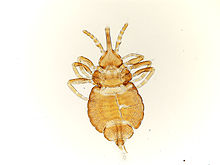| Haematomyzus | |
|---|---|

| |
| Haematomyzus elephantis | |
| Scientific classification | |
| Domain: | Eukaryota |
| Kingdom: | Animalia |
| Phylum: | Arthropoda |
| Class: | Insecta |
| Order: | Psocodea |
| Suborder: | Troctomorpha |
| Infraorder: | Nanopsocetae |
| Parvorder: | Phthiraptera |
| Superfamily: | Rhynchophthirina Ferris, 1931 |
| Family: | Haematomyzidae Enderlein, 1904 |
| Genus: | Haematomyzus Piaget, 1869 |
| Type species | |
| Haematomyzus elephantis Piaget, 1869 | |
| Species | |
| |
| Synonyms | |
| |
The genus Haematomyzus includes three species of lice that differ so markedly from all other lice that the genus is placed in its own family Haematomyzidae, itself monotypic within the superfamily Rhynchophthirina. These unusual lice are ectoparasites of elephants and warthogs. Their mouthparts are elongated to form a drill-like structure that allows them to penetrate the thick skin of their host.
Taxonomy
The three species, Haematomyzus elephantis (elephant louse), Haematomyzus hopkinsi (warthog louse) and Haematomyzus porci (red river hog louse) belong to a single family, the Haematomyzidae, itself the only family within Rhynchophthirina. A molecular phylogenetic study using subunit rRNA sequences suggests a placement of the Rhychophthirina as a sister group of the Anoplura.
| |||||||||||||||||||||
| Phylogeny based on Barker et al. |
Host records
H. elephantis is known from both the African and Asian Elephant in captivity but the species found in the wild are thought to have coevolved with their hosts and further study is required.
Notes
The first spelling of "Rhyncophthirina" by Ferris was a lapse, and in subsequent use of the term he spelled it "Rhynchophthirina" adding the second "h". Ordinal names are not covered by the International Code of Nomenclature and thus the name and spelling comes down to a matter of personal preference. The majority of phthirapterists spell the suborder as "Rhynchophthirina" as did Hopkins and Clay, 1952, and Price et al., 2003.
References
- ^ Piaget, E. (1869). "Description d'un parasite de l'elephant, Haematomyzus elephantis'". Tijdschrift voor Entomologie. 12: 249–254.
- Enderlein, Günther (1904). "Über die Morphologie, Klassifikation und systematische Stellung der Anopluren nebst Bemerkungen zur Systematik der Insektenordnungen". Zoologischer Anzeiger. 28 (4): 136–137.
- Clay, Theresa (1963). "A new species of Haematomyzus Piaget (Phthiraptera, Insecta)". Proceedings of the Zoological Society of London. 141 (1): 153–161. doi:10.1111/j.1469-7998.1963.tb01606.x.
- Emerson, K. C.; Price, Roger D. (1988). "A new species of Haematomyzus (Mallophaga: Haematomyzidae) off the bush pig, Potamochoerus porcus, from Ethiopia, with comments on lice found on pigs". Proceedings of the Entomological Society of Washington. 90 (3): 338–342.
- Ferris, G. F. (1931). "The Louse of Elephants. Haematomyzus elephantis Piaget (Mallophaga: Haematomyzidae)". Parasitology. 23 (1): 112–128. doi:10.1017/S0031182000013494. S2CID 84868661.
- Hopkins & Clay 1952, p. 163.
- ^ Price et al. 2003, p. 466.
- Smith, V. S.; Broom, Y.; Dalgleish, R. "Rhynchophthirina". Phthiraptera.info. Retrieved 11 April 2022.
- Smith, V. S.; Broom, Y.; Dalgleish, R. "Haematomyzidae". Phthiraptera.info. Retrieved 11 April 2022.
- Smith, V. S.; Broom, Y.; Dalgleish, R. "Haematomyzus Piaget, E." Phthiraptera.info. Retrieved 11 April 2022.
- Kapoor, V. C. (1985). Perspectives in Insect Systematics. New Delhi: Inter-India. p. 155.
- Barker, Stephen C.; Whiting, Michael; Johnson, Kevin P.; Murrell, Anna (2003). "Phylogeny of the lice (Insecta, Phthiraptera) inferred from small subunit rRNA". Zoologica Scripta. 32 (5): 407–414. doi:10.1046/j.1463-6409.2003.00120.x. ISSN 0300-3256.
- Price et al. 2003, pp. 79, 396.
- Hopkins & Clay 1952, p. 13.
References
- Hopkins, G. H. E.; Clay, Theresa (1952). A Check List of the Genera & Species of Mallphaga. London: The British Museum (Natural History). p. 13.
- Price, Roger D.; Hellenthal, Ronald A.; Palma, Ricardo L.; Johnson, Kevin P.; Clayton, Dale H. (2003). The Chewing Lice: World Checklist and Biological Overview. Special Publication. Vol. 24. Illinois Natural History Survey. ISBN 1-882932-08-0.
| Taxon identifiers | |
|---|---|
| Rhynchophthirina |
|
| Haematomyzidae | |
| Haematomyzus | |
This parasitic insect-related article is a stub. You can help Misplaced Pages by expanding it. |